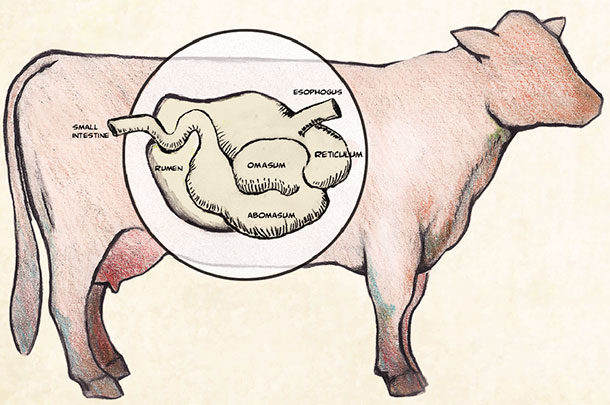We often see ads promoting the benefits of probiotics in a variety of products targeted toward humans and animals. However, ads typically generalize the benefits of probiotics – intertwining nutrition and managing health as research shows how changing diet can have major health benefits. The growing interest in gut health and the impact the gut microbiome has in terms of inflammation and other health challenges cannot be understated.
The gut contains a huge number of microbes collectively known as the gut microbiota. The microbiota provides many functions important to overall health. The human body contains trillions of microorganisms making up about 2 to 6 pounds of beneficial bacteria living within us. Although this is a small amount, the value of our microbiome is vastly important to overall health. The addition of probiotics to the diet helps support the overall microbiota.
The best way to choose a probiotic for your operation is to ask what strain is used in the probiotic and ask to see the research that supports the benefits of the product. Probiotics are not all the same. All living organisms are unique, and bacteria aren’t any different. Within a species of bacteria, there can be thousands of different strains. A strain is a subtype of a microbial species with a unique genetic identity and distinctive morphological, biochemical and behavioral features.
Most of us can relate this to breeds of cattle, although the genetic similarity between breeds is often much greater. For example, the bacterial species Bacillus subtilis has more than 1,000 strains recorded in international strain banks, which contrasts with the 250 recognized cattle breeds. Assuming that two probiotic strains are the same is like assuming you will have the same production traits in a Brahman and an Angus. Finding a research-proven probiotic is the first step to providing your cattle with optimal health.
Building healthy barriers
Multiple studies have determined that between 70% and 80% of the immune system resides within the gastrointestinal tract (GIT). One of the GIT’s primary functions is to form a protective barrier between our bloodstream and the outside world. The enclosed tube of the GIT going from mouth to anus encompasses more surface area than the rest of the body, and because the gut must combat pathogens from everything consumed, the immune system is incredibly important to overall health.
The environment within the GIT is a far more optimal environment for pathogens than the exposed surface of the skin. The GIT is moist, warm and nutrient-rich, making it a great place for pathogens to grow. Thus, probiotics provide additional benefits for minimizing the effects these pathogens may have on health.
Several important probiotic mechanisms responsible for optimizing gut health have been determined:
- Positive modification of the gut microbiota: If you increase the number of good bacteria within the gut, there are less nutrients available for antigens or bad bacteria.
- Competitive adherence to the mucosa and epithelium. If colonization of good bacteria is taking place along the walls of the intestine, there is less room available for bad bacteria to colonize.
- Strengthening the gut barrier and modulating the immune system to promote an advantage to the host; having an immune system that is healthy and quick to recognize and respond to foreign material within the gut that can cause negative health impacts is critical to overall health.
These are the key modes of action probiotics utilize and the ones we will focus on here.
Pathogen and immunity
Many probiotics work to stimulate the animal’s immune response. The immune response is a complex process made up of innate and adaptive immunity. Innate is the natural immune response that is quick to act. The adaptive immune response is based off previous exposure to pathogens; therefore, vaccination programs are so important to animal health. It is slower to act but will provide a greater immune response.
The speed of the adaptive response is increased with previous exposure to a pathogen. The cells largely responsible for producing signaling proteins to regulate immune function lay just underneath the epithelial cells. As the epithelial cell bonds are broken, these cells will be exposed to damage from pathogens, decreasing their effectiveness.
One of the key roles probiotics play regarding the immune system is their unique ability to enhance cytokine production. Cytokines are a key component to a healthy immune system as they are a category of signaling molecules that mediate and regulate immunity, inflammation and blood cell development. Inflammation can reduce the absorption of nutrients across the GIT wall and impact intestinal immunity. Epithelial bonds prevent foreign materials, including pathogens, from entering the intracellular space. Although epithelial bonds are a single cell layer, their role in gut integrity is vital to providing the barrier against pathogens.
Studies have shown that probiotics can have significant benefits in the GIT of cattle. In a published feedlot trial, steers receiving Lactobacillus animalis (LA-51), the most researched cattle probiotic strain on the market today, had a healthier lamina propria. Lamina propria is a thin layer of loose connective tissue that lies beneath the epithelium and, together with the epithelium and basement membrane, constitutes the mucosa. The lamina propria is the site where immunoglobulin IgA is produced – this is an important part of immune function. The study showed that LA-51 leads to healthier lamina propria. Improving the health of the lamina propria will likely lead to improvements in immune function.
Battling inflammation
One of the most detrimental effects on the GIT is inflammation. Inflammation can be caused by tumor necrosis factor (TNF) – an inflammatory cytokine secreted by macrophages, which causes increased intestinal permeability and promotes redistribution of tight junction proteins. Additionally, reactive oxygen species (ROS) produced by neutrophils and macrophages during phagocytosis of bacteria cause increased permeability. These two inflammation causes are associated with an immune response necessary to combat infection.
However, preventing this inflammation is critical to keeping the GIT healthy. One major cause of inflammation is infection. Pathogenic E. coli and salmonella sp. create lipopolysaccharides (LPS), toxins and other factors that can cause the GIT’s tight gap junctions to separate, leading to leaky gut. Leaky gut is one way pathogens can end up in the lungs, liver and lymph tissue. Several studies have shown that intestinal mucus is an efficient system for protecting the epithelium from bacteria.
In a study conducted at Oklahoma State University, steers challenged with E. coli O157:H7 had a significantly improved immune response within 24 hours if they were given a probiotic (LA-51) daily prior to the challenge. Additionally, IgA, an immunoglobulin directly associated with mucus production, was significantly upregulated within the probiotic-treated steers following the challenge. The importance of barrier function within cattle, especially under stress conditions, is critical for optimal animal health.
Our understanding of probiotics and the role they play in a healthy and functional gut has increased over the past 20 years. Producers of cattle within confined feeding systems were early probiotic adopters as the addition of probiotics has helped minimize treatment rates, optimize efficiency, support overall gut health and support a reduction in pathogens that can have major health impacts for consumers.
Probiotics given to cattle every day can help provide the additional support they need to reach their maximum level of efficiency. When asked, “When should I feed a probiotic?” the answer is simple: every animal, every day. ![]()
ILLUSTRATION: Illustration by Corey Lewis.
Jim Turner, Jennifer Schutz and Allen McDonald are technical service managers for Chr. Hansen, Animal Health and Nutrition.









